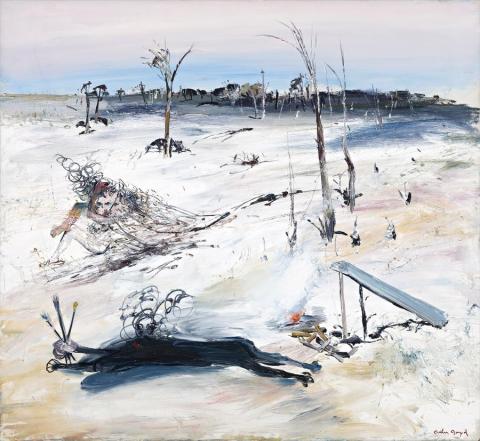THE ARTIST'S CAMP, 1973
ARTHUR BOYD
oil on canvas
92.0 x 101.0 cm
signed lower right: Arthur Boyd
inscribed verso: The Artist's Camp – 1973 / no. 68
Fischer Fine Art, London
Collection of Lex Aitken and Alfredo (Bouret) Gonzalez, Sydney
Arthur Boyd: Recent Paintings, Fischer Fine Art, London, May – June 1973, cat. 68 (illus. p. 31 in exhibition catalogue)
Chained figure and bent tree, 1973, oil on canvas, 152.4 x 122.0 cm, collection of the National Gallery of Australia, Canberra, illus. in Pearce, B., Arthur Boyd Retrospective, Art Gallery of New South Wales, Sydney, 1993, p. 131
Kneeling figure with canvas and black can, 1972, oil on canvas, 114.3 x 190.5 cm, collection of the National Gallery of Australia, Canberra, illus. in Pearce, B., Arthur Boyd Retrospective, Art Gallery of New South Wales, Sydney, 1993, p. 132
Arthur Boyd was an artist of prodigious insight, obsessed with painting, given to working in series, and a mythologizer. The abundance of brilliant paintings he produced are invariably passionate and enigmatic, perhaps none more so that the 'Caged Painter' series to which The Artist's Camp, 1973 belongs. Janet McKenzie found them to be 'among the most difficult to fathom and appear as the most vehement of Boyd's statements about the human condition. They reveal his thoughts at a private and essentially subconscious level.'1 Set in the starkness of the Australian landscape, 'the painter', wrote Ursula Hoff, 'in the seventies is the victim of a world which expects him to perform for reward: he is also at the mercy of his own hyperactivity, of an excess of fantasy.'2 Much is summed up in Chained Figure and Bent Tree, 1973, the artist's head encaged in wire as he overcomes mind manacling restraints to paint, likewise in Kneeling Figure with Canvas and Black Can, 1973 with its metaphorical black dog. Both were shown in the same solo exhibition in London as our painting, and are now in the collection of the National Gallery of Australia, Canberra.
In The Artist's Camp, 1973, the painter becomes the black beast stretched across the foreground, brushes fist-held in seeming anguish and frustration, lovers in the middle ground. The title evokes tradition and invites comparison with the past, possibly Tom Roberts's 1886 painting of the same title in the collection of the National Gallery of Victoria, Melbourne. Gone are the tent and suppertime shared by Frederick McCubbin and Louis Abrahams. Gone is the encompassing bush of Houston's farm at Box Hill. Gone is the companionship between artists and the bush. They are replaced by a crude lean-to and blighted desert. The late twentieth century was, at this particular time, a harsh one for the painter, under challenge from conceptual and other forms of art in which the craft of painting was thought no longer relevant. The metaphor of the barren landscape with its dead and dying trees is meaningful.
The prominence of the black dog with paint brushes leads to Darleen Bungey's observation 'The dog is a doppelganger perhaps, given the descriptive of 'dog' so often attached to Arthur by his friends ...'. She continued, '... the hang-dog, a black symbol of depression, the artist dogged by his own dark thoughts. Arthur would describe the dog as a bestial or sexual element but in so many paintings from this period, to become known as the Caged Artist series, the dog whispers in the artist's ear of images past, visions he must continue to un-see.3 Boyd helps us to see.
1. McKenzie, J., Arthur Boyd: Art and Life, Thames and Hudson, London, 2000, p. 157
2. Hoff, U., The Art of Arthur Boyd, Andre Deutsch, London, 1986, p. 66
3. Bungey, D., Arthur Boyd: A Life, Allen and Unwin, Sydney, 2008, p. 489
DAVID THOMAS
